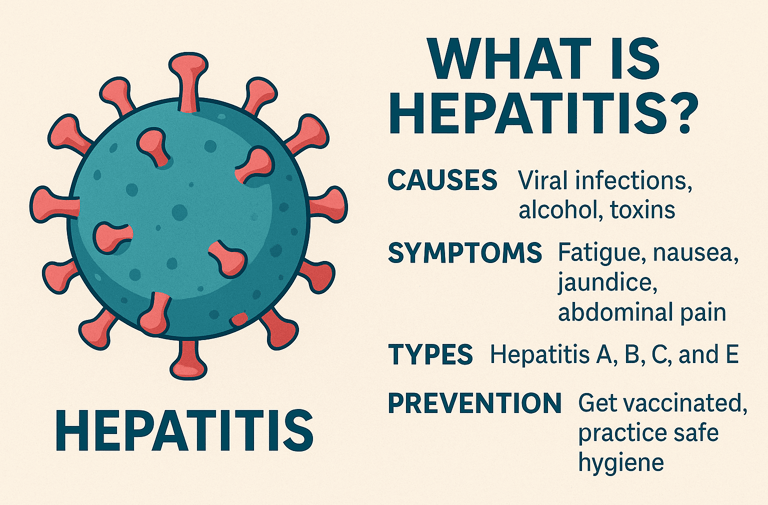Stay updated on what is trending in health. Discover tips and resources for a healthier, balanced life.
What Is Hepatitis? Here’s What You Should Know
Hepatitis explained: Know the causes, recognize the symptoms early, and learn critical prevention tips for A, B, and C, and more to protect your liver health
DISEASES AND CONDITIONS
Dr. S. Ali
9/19/20255 min read


Hepatitis. You’ve probably heard the term, but what exactly does it mean? At its core, hepatitis simply means inflammation of the liver. But the cause, symptoms, and long-term effects can vary a lot depending on the type.
In this article, we’ll break down the different types of hepatitis, what causes them, how they spread, and what you can do to protect your liver.
What Causes Hepatitis?
There isn’t just one cause of hepatitis. It's a condition with many triggers—some infectious, others not. Here's a closer look at the most common culprits:
Viral infections (Hepatitis A, B, C, D, and E)
→ These are the most well-known types. Each virus spreads differently—through contaminated food or water, blood, or bodily fluids—and affects the liver in unique ways.Alcohol abuse
→ Drinking heavily over time can inflame and scar the liver, leading to alcoholic hepatitis. It’s often a warning sign before more serious liver damage like cirrhosis.Certain medications or toxins
→ Some over-the-counter drugs (like acetaminophen in high doses), prescription meds, and environmental toxins can harm the liver and trigger drug-induced hepatitis.Autoimmune hepatitis
→ This rare condition happens when your immune system mistakenly attacks liver cells, causing inflammation. It’s not fully understood, but it’s more common in women.Nonalcoholic fatty liver disease (NAFLD)
→ When too much fat builds up in the liver—even without alcohol—it can cause inflammation and hepatitis. It’s often linked to obesity, diabetes, or metabolic syndrome.
Let’s take a closer look.
The Different Types of Viral Hepatitis
Hepatitis A (HAV)
How you get it: Usually through contaminated food or water, especially in areas with poor sanitation.
Symptoms: Nausea, fatigue, jaundice (yellow skin/eyes), dark urine.
The good news: It doesn’t cause long-term liver damage and most people recover fully. And yes, there’s a vaccine.
Hepatitis B (HBV)
How you get it: Through blood, unprotected sex, or from mother to baby at birth.
Symptoms: Can be similar to Hep A, but many people don’t show symptoms right away.
Chronic risk: If the infection sticks around (chronic hepatitis B), it can lead to liver cirrhosis or cancer.
There’s a vaccine for this too—and it’s very effective.
Hepatitis C (HCV)
How you get it: Mainly through blood contact—like sharing needles or unscreened blood transfusions.
Symptoms: Often silent at first. Many don’t realize they’re infected until liver damage has already occurred.
Chronic and serious: Most cases become chronic, but the good news? It’s curable with modern antiviral treatments (though there's no vaccine—yet).
Hepatitis D (HDV)
How you get it: Only if you already have Hep B—this virus needs Hep B to survive.
Impact: Can lead to a more severe liver disease.
Best prevention: Get vaccinated against Hep B to avoid this too.
Hepatitis E (HEV)
How you get it: Contaminated water, mostly in developing countries.
Usually short-lived: Most people recover on their own.
At-risk group: Pregnant women are at higher risk of severe complications.
Common Symptoms of Hepatitis
Depending on the type and stage, hepatitis can be silent or severe. Some people don’t notice anything until the liver is already under stress. Here's what to look out for:
Fatigue or weakness
→ You might feel constantly tired or drained, even after a full night’s sleep—this is often one of the first signs your liver isn’t working as it should.Loss of appetite
→ Food may suddenly seem unappealing or tasteless, and you might find yourself skipping meals without realizing it.Nausea or vomiting
→ An upset stomach or the urge to vomit can be your body’s way of telling you your liver is inflamed and struggling to detox properly.Abdominal pain (especially upper right side)
→ That dull or sharp ache under your ribs on the right side? That’s where your liver sits—and pain here could be a red flag.Jaundice (yellowing of the skin and eyes)
→ When your liver can't process bilirubin properly, it builds up in your body, causing your skin and eyes to turn yellow.Dark-colored urine
→ If your pee suddenly looks like strong tea or cola, it could be from excess bilirubin being flushed out—another sign of liver trouble.Pale stool
→ Your stool might appear grayish or clay-colored when bile flow from the liver is blocked or reduced.
Important note: Sometimes these symptoms don’t appear for weeks or even months after infection—especially with Hepatitis B or C, which can go unnoticed until more serious liver damage occurs.
Why Hepatitis Matters
Your liver is a vital organ. It processes nutrients, filters toxins, and helps fight infections. Chronic hepatitis—especially Hep B and C—can lead to liver cirrhosis, liver failure, or even liver cancer.
The earlier it’s caught, the better your chances of managing or curing it.
How to Prevent Hepatitis
Great news: hepatitis is often preventable. By taking some simple precautions, you can dramatically reduce your risk. Here's how:
Get vaccinated for Hep A and B
→ These vaccines are safe and effective, offering long-term protection. Hep A is great for travelers, while Hep B is essential for everyone—especially healthcare workers and children.Practice safe sex (use condoms)
→ Hepatitis B and C can spread through sexual contact. Using protection every time helps prevent infection and protects both you and your partner.Don’t share needles or razors
→ Even tiny traces of blood can carry the virus. Whether it’s for tattoos, piercings, or injections—use sterile equipment and never share.Wash your hands regularly, especially after using the bathroom and before eating
→ Hepatitis A spreads through contaminated food and water, so good hygiene is key—especially in areas with poor sanitation.Avoid drinking unclean water, especially when traveling
→ In some regions, Hep A lurks in untreated water. Stick to bottled or boiled water, and skip the ice if you’re unsure of its source.Use only licensed tattoo or piercing parlors
→ Reputable shops follow strict hygiene and sterilization protocols. Make sure they open a fresh needle and wear gloves—every time.And if you work in healthcare or with blood, standard precautions are a must
→ Wearing gloves, using safety-engineered devices, and following infection control procedures help protect both patients and professionals.
Final Thoughts
Hepatitis might sound scary—and in some cases, it can be. But with the right information, smart habits, and regular health checks, it’s completely manageable and often preventable.
If you think you might be at risk, talk to your doctor about getting tested—especially for Hep B and C. Early detection can make a huge difference.
Your liver does so much for you—give it some love back.
Related Articles:
1. Hepatitis B: What You Need to Know About This Silent Liver Infection
2. Fatty Liver Disease: Causes and How to Protect Your Liver
3. Alcohol and Your Health: How the 2025 Blood Pressure Guidelines Change the Picture
Sources:
1. World Health Organization (WHO) – Hepatitis Overview
https://www.who.int/health-topics/hepatitis
2. Centers for Disease Control and Prevention (CDC) – Viral Hepatitis
https://www.cdc.gov/hepatitis/index.html
3. CDC – Clinical Overview of Viral Hepatitis
https://www.cdc.gov/hepatitis/hcp/clinical-overview/index.html
4. WHO – Hepatitis B Fact Sheet
https://www.who.int/news-room/fact-sheets/detail/hepatitis-b
5. WHO – Hepatitis C Fact Sheet
https://www.who.int/news-room/fact-sheets/detail/hepatitis-c
6. CDC – Hepatitis A Clinical Overview
https://www.cdc.gov/hepatitis-a/hcp/clinical-overview/index.html
7. StatPearls via NCBI – Viral Hepatitis Basics
https://www.ncbi.nlm.nih.gov/books/NBK554549/ ncbi.nlm.nih.gov
8. PAHO/WHO – Regional Data & Impact of Hepatitis
https://www.paho.org/en/topics/hepatitis
Pulse Your Health
Empowering you to achieve your health goals.
Contact
© 2025. All rights reserved.
Disclaimer: The content on this website is for informational purposes only and is not medical advice. Always seek the advice of your physician or other suitably qualified healthcare professional for diagnosis, treatment and your health related needs.
